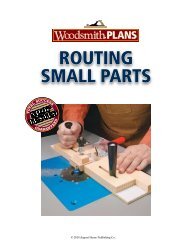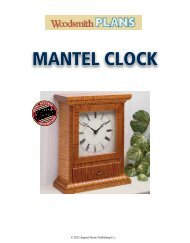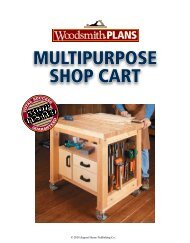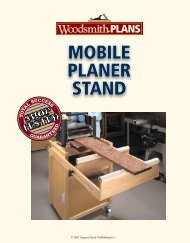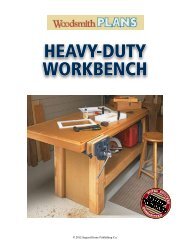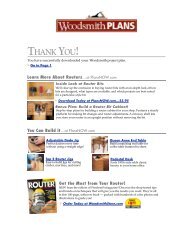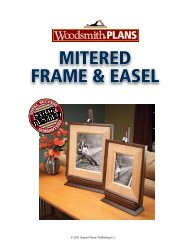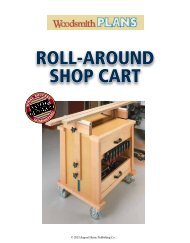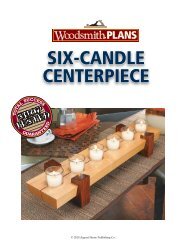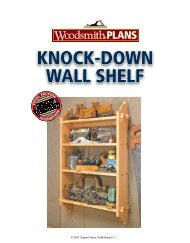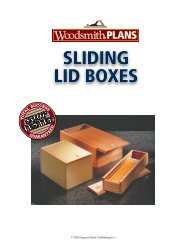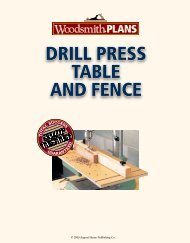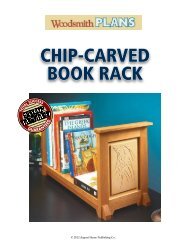Drill Bit Storage - Woodsmith Shop
Drill Bit Storage - Woodsmith Shop
Drill Bit Storage - Woodsmith Shop
- No tags were found...
You also want an ePaper? Increase the reach of your titles
YUMPU automatically turns print PDFs into web optimized ePapers that Google loves.
5FHANGER BLOCK(1%/8" x 2 !/2")GSIDE(4!/2" x 10!/4"- !/4" Hdbd.)a. #/4b.HANGERSLOT#6 x 1!/2"FhWOODSCREWIFGIHIBACK(2!/2" x 4")EFRONT(3" x 4 !/2")GETOP VIEWHANDLEHBOTTOM(2!/2" x 10")HANDLE(3" DRAWERPULLw/SCREWS)NOTE: ALLPIECES EXCEPT SIDES AREMADE OF !/2"-THICK HARDWOODc.FRONT#6 x 1" FhWOODSCREW6 7!/4"RABBETBIT<strong>Storage</strong> BinsIn addition to the two racks, I madea couple of storage bins to hang onthe cleat. As you see in the photoon page 4, each bin is a narrowcontainer that can be used to hold avariety of drill bits and accessories.Size. As with the racks, you maywant to modify the size of the binsdepending on what you plan to putinside them. (I made the bins thesame size as the racks.)!/4FRONTTHICKNESS OF!/4" HARDBOARDEPUSHBLOCKWASTEa. a.Construction. It won’t take long tobuild the bins. As Figure 5 shows,each bin is an open box that’s madeup of a hardwood front, back, andbottom piece and a pair of hardboardsides. Also, a short hangerblock attached to the back providesa way to hook the bin on the cleat.Front. Like the racks, the frontof each bin is made from 1 ⁄ 2 "-thickhardwood. But this time, the front isAUXILIARYFENCEFIRST:CUT DADOIN EACH ENDTO FORMHANGER SLOT!/2F1%/8!/8!/4SECOND:TRIM HANGERBLOCKS TO LENGTHWASTErabbeted on each edge to hold thesides of the bins (Figure 5b).This requires working with afairly small piece. To cut it safely,I used a rabbet bit mounted in therouter table (Figures 6 and 6a.)Setting up the router table is asimple two-step process. First, setthe fence so the width of the rabbetwill match the thickness of thematerial used for the sides ( 1 ⁄ 4 " hardboard).Second, adjust the height ofthe bit to cut a 1 ⁄ 4 "-deep rabbet.Now turn on the router, place theedge of the workpiece against thefence, and use a push block to feedit across the bit (Figure 6).Hanger Blocks. Once the frontpieces are completed, you can turnyour attention to the hanger blockfor each bin. It’s a short, 1 ⁄ 2 "-thickhardwood block with a slot in thebottom that hooks onto the rail onthe cleat (Figures 5 and 5a).The size and location of this slotare the same as the one in the top ofeach rack (Figure 7a). But again, thehanger blocks are fairly small. So it’sbest to start with an extra-long pieceand cut a dado in each end to formthe slot (Figure 7). Then trim eachhanger block to length.3 <strong>Woodsmith</strong><strong>Shop</strong>.com © 2010 August Home Publishing Co. All Rights Reserved.
Add the Sides. At this point, it’s timeto add the sides of the bins. To see ata glance what’s inside the bins, thesides are scooped out to form a long,deep notch. It only takes a few minutesto make these notches.After cutting blanks for the sides(two for each bin), lay out the notchand use a band saw (or jig saw) tocut about 1 ⁄ 8 " to the waste side of theline. The rest of the material canbe removed using a drum sanderchucked in the drill press, as illustratedin Figure 8.To sand the entire thickness ofthe workpiece, you’ll need to “bury”the lower part of the drum sander ina hole that’s cut in an auxiliary table.(I attached a piece of plywood to thedrill press table.) You’ll also wantto locate a straight piece of woodto use as a fence. After notching itto fit around the drum sander, positionthe fence to sand to the desireddepth and clamp it in place.To produce identical notches, it’sa good idea to attach the two sideswith double-sided tape. Then, afterturning on the drill press, start atthe right end of the notch and pushthe workpiece into the drum sanderuntil the “feet” contact the fence.Slowly feed the workpiece from leftto right to sand the edge smooth.Bottom & Back. To complete eachbin, I added a hardwood bottom andback. These pieces are assembledwith ordinary butt joints. But first,be sure to pre-drill holes in the frontfor the machine screws that hold thehandle (Figure 5c). Then assemblethe bins with glue and screws.› One of the simplest ways to organizedrill bits and accessories is to store them in woodblocks that fit inside the bins.8FEEDDIRECTIONFENCE2"DRUMSANDERNOTE:CUT HOLE INAUXILIARY TABLETO ACCEPTDRUM SANDERUSE DOUBLE-SIDEDTAPE TO HOLD TWOSIDES TOGETHER1AUXILIARYTABLE1"RAD.NOTCHDETAIL2!/2wall-mounted cleatAs you can see in the photos below, theracks and bins hang on a simple cleatthat mounts to the wall.To provide rigid support, the cleat consistsof two parts: a hardwood mountingplate and a rail made from aluminumangle bracket (Figure 9). After drillingthree shank holes in the rail, it’s simplyscrewed to the top edge of the cleat.Determine Length. Just a note aboutthe length of the cleat. To hold all fourhangers, the cleat shown is 12" long.Since I planned to screw the cleat directlyto a wall covering made of fir plywood, Ididn’t have to worry about the screwshitting the wall studs. If you plan to fastenthe cleat to wallboard, be sure to make itlong enough to anchor it in the studs.9#8 x 1" SHEETMETAL SCREWNOTE: SCREW SIZEWILL VARY DEPENDINGON HOW CLEAT ISMOUNTED TO THE WALLRAIL(#/4" x #/4" x 12"ALUMINUMANGLE)ENDVIEWJMOUNTINGPLATE(3!/2"x 12" -#/4"-THICK HARDWOOD){ Cleat. A two-part cleat that’s made up of a hardwood mounting plateand a metal rail lets you hang each of the racks (left) and bins (right)on the wall. Just be sure to anchor the cleat securely to the wall.4 <strong>Woodsmith</strong><strong>Shop</strong>.com © 2010 August Home Publishing Co. All Rights Reserved.



